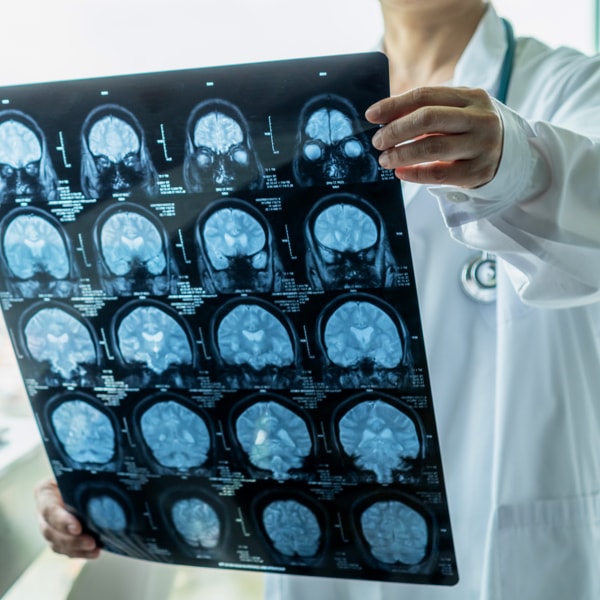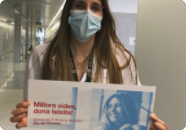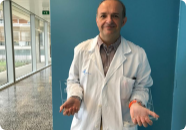- Home
- Citizenship
- Clinical specialties and services
- Hospital de Sant Joan Despí, Hospital General de l'Hospitalet, CAE Cornella, CAE Sant Feliu, CAE Ronda la Torrassa
- Neurology
Hospital de Sant Joan Despí, Hospital General de l'Hospitalet, CAE Cornella, CAE Sant Feliu, CAE Ronda la Torrassa
Neurology
- About the Observatory
- Team
- Units and benefits
- Diseases and procedures
- Research
- Teaching activity
- Related information

About the Observatory
The Neurology Service of the Moisès Broggi Hospital Complex (Sant Joan Despí Hospital and Hospital General de l'Hospitalet) is intended to be a point of reference and to provide quality assistance for neurological pathologies in a territory of 430.000 inhabitants (populations of Sant Joan Despí, Cornellà de Llobregat, Esplugues de Llobregat, Sant Just Desvern, Sant Feliu de Llobregat, the Papiol, Molins de Rei and the Hospitalet Nord area).
The service is governed by a patient-centred care model and aims to be a model of excellence.
Although it is an eminently healthcare service, there are outstanding areas or units that enjoy special recognition in Catalonia, Spain and within the international community, such as the Movement Disorders Unit or the Sclerosis Unit Multiple (EM). The service was a pioneer in Spain in establishing the joint visit of Neurology and Specialized Nursing for MS. The good clinical results, the impact on the reduction of the recurrence rate and the greater satisfaction of the patient have meant that this joint visit has begun to be established in other places in the State.
The service attends to all neurological pathology except for intravascular rescue of stroke and plasmapheresis, for which the reference center is the Bellvitge Hospital.
The specialized consultation in the area depends directly on the service, as the specialists travel to the specialized care centers (CAE) which include Cornellà de Llobregat, Sant Feliu de Llobregat and la Torrassa. There is also the virtual consultation of Neurology between primary care doctors and the service
-
Update date: 01.01.2022
Head of Service
-
Anna Planas Ballve
neurology hsjd
specialist doctor
-
Maria Asuncion Avila Rivera
neurology hsjd
service coordinator doctor
-
Evelio Peral Pellicer
neurology hsjd
specialist doctor
-
Irati Zubizarreta Nafarrate
neurology hsjd
specialist doctor
-
Juan Bello Lopez
hgh neurology
area coordinator doctor
-
Juan Jose Mengual Chirif
neurology hsjd
specialist doctor
-
Laura Gubieras Lillo
neurology hsjd
specialist doctor
-
Luis Miguel Cano Sanchez
neurology hsjd
specialist doctor
-
Luis Mena Romo
neurology hsjd
specialist doctor
-

Mari Carmen Edo Cobos
neurology hsjd
specialist doctor
-
Nuria Cayuela Caudevilla
neurology hsjd
specialist doctor
-
Susana Fernandez Gonzalez
neurology hsjd
specialist doctor
-
Jose Vicente Hervas Garcia
neurology hsjd
specialist doctor
-
Sonia Maria Garcia Sanchez
neurology hsjd
specialist doctor
In this section appear the professionals of the Integral Health Consortium who have authorized the display of their personal data.
-
Update date: 01.01.2022
Units and benefits
- Entry:
- General admission It includes admission to a conventional Neurology facility and is based on acute or chronic re-acute neurological pathology, such as acute or subacute strokes that do not meet the stroke unit criteria, post-stroke, cognitive impairments, peripheral nervous system pathology ( Guillain-Barré syndrome, myasthenia gravis), demyelinating pathology with acute onset by diagnosis, unique space-occupying lesions by parentage.
- Initial evaluation
- Daily monitoring
- Hospital discharge
- Admission to the Stroke Unit:
- Initial evaluation
- Daily monitoring
- Hospital discharge
- Diagnostic technique: monitoring (cardiac monitoring, electrocardiogram, blood pressure, heart rate, oxygen), Neurosonology
- Scheduled admission for specific neurological problems:
- Therapeutic adjustment, if there is poor control
- Urgent diagnostic procedures
- other
- Hospital interconsultations
- Neurological polysomnography (sleep pathology: conventional neurological polysomnography, multiple latencies test)
- Service professionals with a mobile phone for urgent interconsultations on the floor or in the Emergency Department
- General admission It includes admission to a conventional Neurology facility and is based on acute or chronic re-acute neurological pathology, such as acute or subacute strokes that do not meet the stroke unit criteria, post-stroke, cognitive impairments, peripheral nervous system pathology ( Guillain-Barré syndrome, myasthenia gravis), demyelinating pathology with acute onset by diagnosis, unique space-occupying lesions by parentage.
- Hospital standard external consultation
- First visit: 30 minutes
- Second visit: 20 minutes
- First dementia visit: 60 minutes
- First EM visit: 45 minutes
- Second EM visit: 20 minutes
- Specialized areas and units:
- Area of neurodegenerative diseases: includes the Rapid Diagnostic Units and specific dementia consultations
- Multiple Sclerosis Unit
- Movement Disorders Unit
- Rapid Diagnostic Units (UAR)
- Specialized consultations (monographic, special):
- Neurovascular expert consultation
- Epilepsy expert consultation
- Expert consultation on botulinum toxin
- Expert consultation on headaches
- Expert consultation in the peripheral nervous system
- Expert consultation in Neuro-oncology
- General neurology hospital consultations
- Day hospital
- Administration of intravenous treatments
- Lumbar punctures
- Analytical monitoring of treatments
- Face-to-face consultations by doctor and specialist nurse
- Apomorphine test
- Application of stairs: Ambulation test, 9HPT, 25 steps...
- Stroke code and intravenous fibrinolysis (specific stroke code search)
- Daily emergency care (scheduled)
- Emergency telephone assistance (Neurology mobile)
- 24-hour on-site Neurology Guards
Techniques carried out in the outpatient clinic:
- Non-surgical invasive:
- Electromyogram (conventional, medium, long, jitter and repetitive stimulation)
- Outpatient lumbar puncture
- Infiltration with botulinum toxin:
- Dystonia (blepharospasm, craniocervical and segmental dystonia), hemifacial spasm, axillary and palmar hyperhidrosis, sialorrhea, spasticity (mainly second stroke and multiple sclerosis)
- Chronic migraine
- Neuropsychological examination:
- First assessment: wide systematic battery
- Follow-up: extensive systematic battery
- Assessment of the Intellectual Quotient (IQ)
- Non-invasive:
- Electroencephalogram (standard, long, sleep deprivation, intensive)
- Transcranial Doppler
- Transcranial duplex
- Supraaortic trunk duplex (TSA)
- Patent foramen ovale (FOP) study: right-left shunt
- HITS monitoring
- Intravenous fibrinolysis monitoring
- brain dead
- Pharmacological tests:
- Apomorphine test
- Edrophonium test
- Services of the specialized nursing staff:
- Health education of patients with multiple sclerosis: treatments, management of adverse effects, etc.
- Health education of patients with dementia: treatments, management of adverse effects, etc.
- Administration of intravenous treatments
- Treatment monitoring analytics
- Dispensing medication
- Face-to-face consultations
- Telephone inquiries
- Mobile care for the chronic neurological patient
- Mobile care for patients with multiple sclerosis
- Assistance with lumbar punctures
- Apomorphine test
- Nursing assessment reports
- Botulinum toxin consultation support
- cures
- Edrophonium test
- Ambulation test and upper limb functionality
- Application of spasticity, quality of life and pain scales
- Multiple Sclerosis RPT Registry
- Registry of Alzheimer's treatments from CatSalut
-
Update date: 01.01.2022
Diseases and procedures
-
dementias
They are a group of diseases that are characterized by the loss of cognitive abilities (for example, memory, language, reasoning) and that reduce the person's ability to carry out their daily activities. These diseases are linked to age. For this reason, the increase in life expectancy of the population will increase its prevalence.
The most common type of dementia is Alzheimer's disease (it accounts for 60% of all dementias). Currently, there is no treatment that cures or stops the disease, but there are some symptomatic treatments that have shown modest effectiveness in cognitive deficits and behavioral alterations.
For now, it is considered that the only way to clinically improve patients is to establish an early diagnosis that allows pharmacological treatment to start early, in order to favor the stabilization of cognitive, behavioral and functional impairment.
-
Stroke
Stroke or acute cerebrovascular accident is the second leading cause of death in the world and one of the most disabling diseases.
In Catalonia, stroke is the second leading cause of death and the leading medical cause of disability, with more than 13.000 admissions per year. Basically, there are two types of stroke: ischemic, due to the closure of one of the arteries that bring blood to the brain, and hemorrhagic, due to the rupture of one of these arteries.
Actions in the acute phase of stroke between 2005 and 2012 prevented the death of 1.107 people aged 45 and over in Catalonia. For this reason, early recognition of stroke symptoms and their treatment during the first hours of the illness is important.
Sant Joan Despí Hospital and l'Hospitalet General Hospital are part of the stroke code network in Catalonia, an integrated system that allows the transfer of stroke patients to the nearest hospital capable of administering treatments in the initial phase of the stroke. During the year 2021, there has been a 34% increase in stroke codes treated at the center compared to 2020 and a 30% increase compared to 2019 (pre-pandemic year). All this led, with the approval of CatSalut, to the Sant Joan Despí Hospital opening the Stroke Unit during the last quarter of 2021, which has allowed better care for patients with this pathology that it accounts for almost 80% of the reason for admission to the Neurology service.
-
Parkinson's disease
Parkinson's disease is the second most common neurodegenerative disease. Although it usually appears after the age of 60, there are more and more cases that start earlier. The cause is usually unknown although it is known to be a chronic neurodegenerative disorder that involves the loss of groups of neurons in the brain.
It can manifest itself in many different ways, although the most well-known symptoms are the motors, which tend to appear on one side of the body and then spread to the other. These motor symptoms are mainly tremor, stiffness, slowness of movement and gait and posture disorder. However, there are also many non-motor symptoms, not so visible, which can affect the mind more than the body, and influence the patient's quality of life more: pain, low blood pressure, memory loss, hallucinations , impulsivity, depression, anxiety, sleep disturbance, sweating, seborrhea or urinary and gastrointestinal disorders.
The diagnosis of Parkinson's disease is made by a neurologist based on the clinical manifestations presented by the patient. It should be considered that not all parkinsonism is caused by Parkinson's disease. Complementary tests, such as analytical tests with different parameters, cranial CT, cranial magnetic resonance or brain SPECT, are not mandatory but may be required if the neurologist considers it appropriate to rule out other diseases that can simulate Parkinson's disease or aggravate the symptoms.
Treatment should be initiated when symptoms interfere with any of the activities of daily living. The recommendation is always to go to the specialist. Although levodopa is the main drug in the treatment of Parkinson's disease, there are others widely used in daily practice. It is the neurologist who will initiate the best therapy according to the recommendations stipulated for each patient and each phase of the disease.
The future of Parkinson's disease is focused on finding new drugs and, above all, on being able to identify a biomarker (genetic, molecular or neuroimaging) that allows recognizing people at risk of developing the disease, better monitoring and even researching drugs that slow down the natural progression of Parkinson's.
-
Headaches
Headache accounts for 25-30% of first visits to a general neurologist and is the most frequent reason for neurological consultation in primary care. The possible causes of a headache are numerous, but the vast majority are migraines or tension headaches, that is to say, primary headaches in which "the headache is the disease itself". In less than 10% of cases the headache is a symptom of another disease (secondary headache) and in these cases it is necessary to carry out complementary examinations to arrive at the diagnosis.
Migraine affects 15% of the population and is three times more common among women. The maximum prevalence is between 25 and 55 years. It represents the second most incapacitating neurological pathology and with great health expenditure, only surpassed by dementia.
Along with primary care, criteria for referral to Neurology and Emergency have been established according to the characteristics of the headache, in a fluid relationship.
8% of migraine sufferers end up with chronic migraine, which causes the most disability. The Sant Joan Despí Hospital and the Hospital General de l'Hospitalet have a specific botulinum toxin treatment unit for patients with chronic migraine who do not respond to the usual preventive treatments.
-
Epilepsy
Epilepsy is a chronic disorder characterized by the presence of recurrent, unprovoked seizures (caused by some reversible medical condition, such as alcohol withdrawal or extremely low sugar levels). It affects 0,7-1% of the population.
A person is considered to have epilepsy if they have had two unprovoked seizures (or one unprovoked seizure with known risk factors for recurrence present). Seizures in epilepsy may be related to brain injury or a family tendency, although the cause is often unknown.
Having epilepsy can affect personal integrity, personal relationships, work and driving motor vehicles, among other factors. The negative prejudices of the population towards epilepsy and the treatments employed may be more important (and difficult to treat) problems than the crises themselves.
-
multiple sclerosis
Multiple sclerosis is an inflammatory, autoimmune and chronic neurological disease that affects the central nervous system (brain and spinal cord). It is the first cause of disability in young adults due to illness.
In this disease, the immune system attacks the myelin, a substance that surrounds the nerve fibers or neurons so that the transmission of the nerve impulse is correct. If myelin is destroyed or damaged, neuronal communication is delayed or interrupted and symptoms appear, which are wide and varied and affect each person differently. The most common symptoms include fatigue, limb weakness, sensory disturbances, visual disturbances and balance problems.
The cause of multiple sclerosis is unknown but it is thought to be a combination of a genetic predisposition and environmental causes. On the other hand, it is known that it is a non-contagious disease, neither hereditary nor fatal. Its evolution is different for each person and there are different types of multiple sclerosis.
Today it is a disease that, although it does not have a cure, does have an effective treatment that, if applied from the beginning and individualized for each patient, can change the course of the disease and make does not develop a disability or that this is not significant. In the same way as in other neurological diseases, such as stroke, "Time is Brain", which means that consulting in time can change your prognosis.
-
Update date: 01.01.2022
Teaching
Collaboration of team members in multiple national/international courses and conferences with keynote presentations for Neurology residents, general neurologists and specialized neurologists
- 4th year Medicine students of the University of Barcelona (4 groups of 10-12 students per group/year)
- Psychology students at the University of Barcelona (7 students/year)
- Master of General Psychology at the University of Barcelona (6 students/year)
- Master's in Adult and Child Neuropsychology from the Autonomous University of Barcelona (1 student/year)
- Master's in Neuropsychology from the Instituto Superior de Estudios Psicológicos (2 students/year)
- Master's in Neuropsychology from the Open University of Catalonia (2 students/year)
- 2nd year Internal Medicine Residents (2/year)
- 3rd year Residents of Family and Community Medicine Costa de Ponent (8-10/year)
- Geriatrics Residents (1/year)
- 2 associate professor positions at the University of Barcelona (Medicine)
- 1 associate professor position at the University of Barcelona (Psychology)
- Continuous internal training with weekly update sessions on diagnosis and therapeutic management of neurological pathology
-
Update date: 01.01.2022
-
Update date: 01.01.2022








